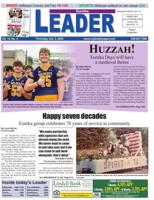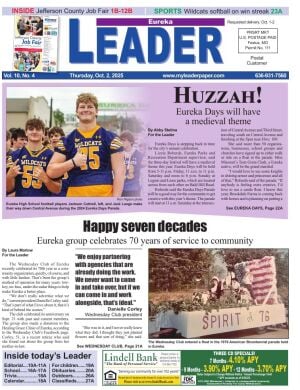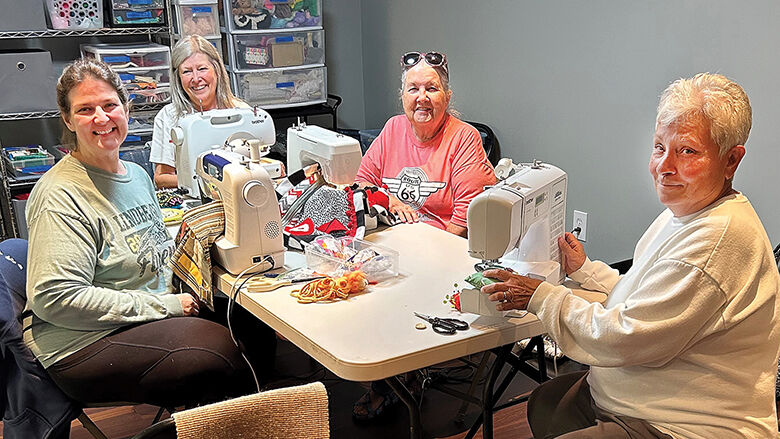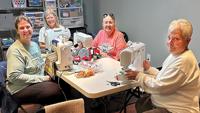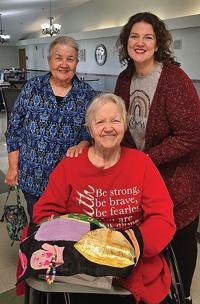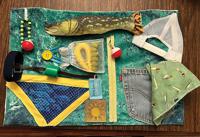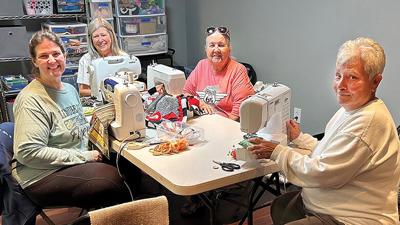Emily Bowman Cook hopes her efforts to ease the struggles dementia patients face will be a fitting memorial to her mother, who waged a long and difficult fight against the condition.
Cook, 46, of Fenton is part of a group of women working to create fidget mats for Alzheimer’s patients and those with dementia. The mats are created from ordinary placemats, embellished with manipulative items like buttons, zippers, pockets and buckles.
Cook’s mother, Susan Hunter Bowman, a longtime Jefferson R-7 School District teacher, died in 2019 at age 69 of complications from her yearslong battle with dementia. Her daughter has followed in her mother’s educator footsteps, working in the library at the Lindbergh School District’s Sperreng Middle School, where she also is involved in the PTO and heads the annual fundraising holiday house tour. Fidget mats are her latest project.
“I think my mom might’ve benefited from something like this,” she said. “I never got her a doll or anything manipulative, and I have some regret from that. I didn’t have the knowledge at the time to look for the signs of hand fidgeting.”
Those affected by dementia can benefit from having something repetitive to do with their hands.
“It helps them with anxiety,” Cook said. “As part of her dementia, my mom was irritable and even combative, and I think something like one of these (mats) could have helped calm her down and soothe her.”
Also known as fidget blankets, sensory blankets or activity blankets, the mats are designed to provide sensory stimulation and promote relaxation. According to the Caregivers Support Network, they can stimulate the senses, aid in memory recall and improve cognitive function, as well as reduce anxiety, stress and agitation.
Cook said a friend recruited her to help with the fidget mats.
“She had seen a lady post, looking for helpers to make them,” Cook said. “Knowing this is a topic that is close to my heart and that I could sew, she reached out to me.”

Sharon Miller, left, and Emily Bowman Cook present one of their custom fidget mats to Crystal Oaks resident Rose Rueve.
Cook was put in touch with Sharon Miller, whose late husband had Alzheimer’s.
“She had noticed that he and other people with dementia were always fidgeting – running their hands up and down whatever they were touching, stretching their clothing, picking at threads – and she had seen an article in the AARP magazine about fidget mats and how they can help.
“I met up with her and she was thrilled to have the help. She recruited a few people, I recruited a few, including some from the National Honor Society at Lindbergh (High School).”
The group meets regularly in one member’s basement to sort materials and sew the mats, which they then donate to assisted living facilities such as Delmar Gardens Meramec Valley in Fenton and Crystal Oaks in Festus.
Got any leftover stuff?
The group is seeking donations of materials used to create the mats, including all kinds of fabric and a wide array of accessories.
“Placemats are the base,” Cook said. “We always try and put a zipper on there, and a buckle of some sort that can slide along a strip of fabric. We use buttons, the bigger the better, any color or shape. We like to put on a pouch or pocket, with a small item attached that can go in and out. We use faux fur or other fabrics for texture, and tags like the small silk ones that go on the outside edge of baby blankets.”

The group recently created a mat for a man who had been a fishing enthusiast. It included bobbers, a fish toy, part of a baseball cap, rubber worms and other pieces of fabric.
Some other items used in the mats include small soft dolls or puppets; stretchy headbands; small mittens; makeup pouches; Barbie doll clothes; marbles or glass beads; shoelaces; pony beads; lace; rope or braided fabric.
“We like to put on something stretchy, like a scrunchie or an elastic band, and then sometimes little socks or gloves they can put their hand inside. Just anything that can be safely manipulated.”
The team will also gladly accept monetary donations to purchase materials and supplies.
“We also are looking for a sewing machine that someone has sitting around not being used,” Cook said. “We have a space that is set up for sewing, and it gets tedious to lug my machine back and forth. We would love to have an additional machine that can stay in place.”
Cook said for patients like her mother, keeping hands busy can be a lifesaver.
“One of the cruel things about dementia is that people lose abilities,” she said. “They have a tough time reading or using a computer, even watching TV. This gives them something to keep their hands and their minds busy.”
For more information or to arrange a donation, contact Cook by email at STLMemoryMats@gmail.com.
